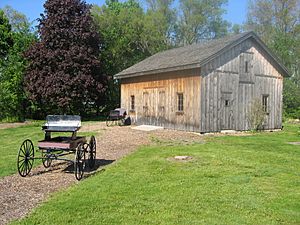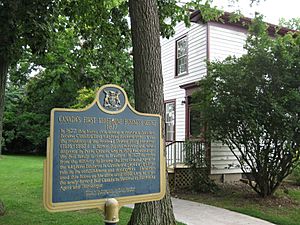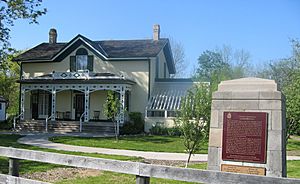Bell Homestead National Historic Site facts for kids

Melville House at the Bell Homestead National Historic Site, Alexander Graham Bell's first home in North America
|
|
| Lua error in Module:Location_map at line 420: attempt to index field 'wikibase' (a nil value). | |
| Established | 1910 |
|---|---|
| Location | 94 Tutela Heights Road Brantford, Ontario |
| Owner | Parks & Recreation Department, City of Brantford |
| Official name: Bell Homestead National Historic Site | |
| Designated: | 1996 |
The Bell Homestead National Historic Site in Brantford, Ontario, Canada, is also known as Melville House. It was the first North American home of Professor Alexander Melville Bell and his family. This included his son, the famous scientist Alexander Graham Bell. The younger Bell did his first experiments in North America here. He later invented the telephone at the Homestead in July 1874. Alexander Graham Bell once said, "the telephone problem was solved, and it was solved at my father's home."
This 4-hectare (101⁄2 acre) site looks much like it did when the Bells lived there in the 1870s. Melville House is now a museum about the family and the telephone. There is also a large visitor center next to Melville House.
The Henderson Home building was moved to the Homestead in 1969. It was originally in downtown Brantford. This building was Canada's first telephone company office, opened in 1877. It was a very early version of what became Bell Telephone Company of Canada. After moving to the Bell Homestead, it became a museum about the history of telephone technology. The City of Brantford's Bell Homestead Committee runs the Homestead.
The Homestead became a National Historic Site on June 1, 1996. It was added to the national Register of Historic Places on June 22, 2009. Queen Elizabeth II unveiled a new plaque there in 1997. This was during the 150th anniversary of Alexander Graham Bell's birth. Melville House has been called "...this shrine, where lingers the spirit of the great inventor".
Contents
The Bell Family's New Home
The Bell family arrived in Canada in the summer of 1870 from Scotland. Two of their sons had died from tuberculosis. Their middle son, Alexander Graham Bell, was also very sick. The Bell Homestead today has several buildings. The main building is Melville House, the farmhouse of Alexander Melville Bell. It also has a greenhouse, other small buildings, and a fruit orchard. The farmhouse and its land were bought in 1909 to be a museum.
The Henderson Home, which was Canada's first telephone office, was moved to the site in 1969. It was made into a separate telephone museum in 1970. Bell Canada helped a lot with this. A tea house, a visitor center with a small theater, and other facilities were also added. These additions help welcome visitors and tour groups. The Tutelo First Nations people lived across the street from the Bell Homestead.
Father and Son: A New Start
Professor Alexander Melville Bell, a Scottish expert on speech, moved to Canada by steamship in July 1870. He came with his family and his daughter-in-law. His oldest son had died from tuberculosis that May. His youngest son had died three years earlier. His middle son, Alexander Graham, seemed to be getting sick with the same disease.
The Bells arrived in Quebec City on August 1, 1870. They then traveled to Montreal and took a train to Paris, Ontario. They stayed with Reverend Thomas Philip Henderson, a close family friend. Henderson had invited the Bell family to Canada. After a few days, the Bell family bought a 51⁄4 hectare (13 acre) farm. It was in Tutelo Heights, near Brantford, Ontario. They paid CA$2,600 for it.
When they left the UK, Alexander Graham's health was very poor. He was very thin. But in Canada, he liked the climate and quickly got better. He later said, "I came to Brantford in 1870 to die; I was given six months lease of life, but I am glad to be alive today..."
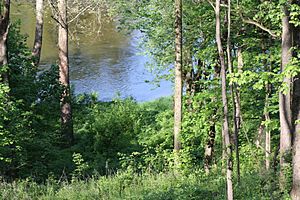
The local newspaper, the Brantford Expositor, announced the Bell family's arrival. Alexander Graham Bell set up his laboratory in the farm's old carriage house. Nearby was his "dreaming place," a hollow in the elm trees above the river. He would relax there, think, and watch the Grand River. Even though he was weak when he arrived, Alexander Graham's health quickly improved.
Alexander Graham continued his studies of the human voice. He learned the Mohawk language from the Six Nations Reserve across the river. He translated their spoken words into Visible Speech symbols, a writing system his father invented. For this work, he became friends with the tribe. He was even made an Honorary Chief and took part in a ceremony.
In his carriage house lab, Alexander Graham also continued his electrical experiments. He changed a melodeon (a type of organ) so it could send music electrically over a distance. Once the family was settled, Alexander Graham and his father planned to teach. His father sent him to Boston to teach for a good amount of money. For several years, Alexander Graham lived and worked in Boston during the school year. He returned to his parents' home in the summers to rest and work on his telegraph and telephone research.
During his summer vacation at the Homestead in 1874, Alexander Graham thought about how to reproduce sound electrically. He believed he could send "sounds of any sort" by changing the strength of an electric current. This was a new idea, different from the on-or-off signals other inventors used. He talked with his father about how a sound-driven transmitter could send an electrical signal to a receiver. On July 26, 1874, in their living room, the younger Bell understood the main ideas of how a telephone would work. He invented the device he is now famous for.
The next summer, in 1875, Bell wrote the first plans for his telephone patent at the Homestead. This patent is considered one of the most valuable in history. He built his first working telephone in Boston on March 10, 1876. Later that year, in August, Bell made the first successful voice transmission over a long distance, between Brantford and Paris, Ontario.
On July 26, 1974, Canada Post released a stamp honoring the 100th anniversary of the telephone's invention. It said, "At Brantford... Alexander Graham Bell, a young teacher of the deaf, spent a few weeks of leisurely contemplation and invented the telephone." The stamp showed three telephones, including his famous Gallows model, which was the world's first telephone.
Three Big Telephone Tests
After getting his U.S. Patent No. 174465 in March 1876, Bell came back to Melville House for the summer. He did three important tests of his new telephone. The third and most important test was the world's first true long-distance call. It happened between Brantford and Paris, Ontario, on August 10, 1876. For this call, Alexander Graham Bell used telegraph lines at Robert White's Boot and Shoe Store in Paris. The line was about 13 km (8 miles) long between Paris and Brantford. It was extended another 93 km (58 miles) to Toronto to use a battery there.
When the lines were connected, Graham Bell heard "explosive sounds... mixed with a continuous crackling noise." Bell fixed his device by changing the receiver's electromagnet. Suddenly, voices came through "clearly and strongly" over the 106 km (66 miles) line. From Brantford's Dominion Telegraph office, Professor Alexander Melville Bell sang songs, quoted Shakespeare, and read poetry to his son in Paris. People in Paris gathered to hear Melville's voice from the simple metal box. Alexander Graham Bell could not talk back directly. He replied by telegraph on a separate line. Still, Alexander Graham later said this was the first one-way long-distance call "of several miles."
This third test in Southern Ontario was the world's first long-distance call. It showed that the telephone could work well over long distances, not just short ones.
One week earlier, on August 3, 1876, Alexander Graham's uncle, Professor David Charles Bell, spoke to him from the Brantford telegraph office. He recited lines from Shakespeare's Hamlet. The young inventor was at the A. Wallis Ellis store in Mount Pleasant. He listened to his uncle's voice from his receiver. At first, David Bell's voice was not clear. But when a battery was added to the telegraph line, "the voices then came in distinctly."
The next day, August 4, another call happened between Brantford's telegraph office and Melville House. A large dinner party, including the Cowherd family, provided "speech, recitations, songs and instrumental music" that were sent to the Bell Homestead. To get the telephone signals to Melville House, Alexander Graham bought all the stovepipe wire in Brantford. With help from neighbors, he strung the wire about 800 meters (half a mile) along fence posts from his parents’ home to the Mount Pleasant telegraph line. This line connected to the Dominion Telegraph office in Brantford.
Scientific American wrote about these test calls on September 9, 1876. Historian Thomas Costain called them "the three great tests of the telephone."
Melville House: The Bell Family Home
Melville House was the name Alexander Melville Bell gave to his home. This large, two-story wooden farmhouse was built in 1858 for Robert Morton. It was a neoclassical Italianate villa style home. The house was built among tall elm trees. It had pine floors, walnut window trims, and high ceilings. It also had a low-pitched roof and a decorative front porch. The younger Bell even installed a bathtub and shower, which was very rare at the time. The house had a large kitchen, dining room, parlor, study, and four bedrooms upstairs. The Bells also added a greenhouse to the side of the house.
The property, which is next to the Grand River, originally had a 4-hectare (10.5 acres) fruit orchard, a farmhouse, stable, pigsty, henhouse, icehouse, and a carriage house. During the 11 years the Bells lived there, the farm helped them earn money. They sold plums, cherries, pears, apples, and peaches. The Bell family was not rich, but they were upper-middle class. They relied on selling their farm products.
Melville sold the homestead in 1881 to join his son in Washington, D.C. The farmhouse changed owners five more times. In 1909, the Bell Telephone Memorial Association bought it. This group was raising money for a big memorial to Alexander Graham Bell and the telephone. In 1910, Melville House became a museum. It honored the Bell family and Alexander Graham's invention of the telephone in July 1874. The Association gave the Homestead to the City of Brantford in 1917. It took many years to restore the home to its original look. In 1925, it was moved 25 meters (80 feet) closer to Tutela Heights Road. This was done because the river bank was eroding.
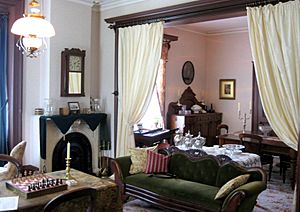
The Bell Homestead Museum first opened in October 1910 with two rooms. Over many years, it bought back or received donations of many of the Bell family's original items. These included furniture, cabinets, and their piano-like melodeon. Eventually, 90% of their Melville House furnishings were returned. Donations from Bell family members also included books, china, and a silver tea set that was a wedding gift to Alexander Graham and his wife Mabel Bell. The original melodeon was given to the museum by the granddaughter of Jenny Cowherd. Jenny's father, Thomas Cowherd, supplied stovepipe wire to Graham Bell. Her brother, James, built almost 2,400 telephones for Bell's company. Jenny also played the melodeon and sang for some of Alexander Graham's telephone demonstrations.
Many of these items had been sold at an auction in 1881 when Melville and his wife moved. They were later donated back to the Melville House Museum. A third room on the ground floor was not opened to the public until 1947.
The Homestead and Melville House museum have special programs, like Christmas holiday celebrations. The farmhouse is decorated in the style of Alexander Graham Bell's American wife, Mabel. Costumed guides and presentations help visitors have a personal experience. The museum is praised for being very real. One reviewer wrote that the house "has a comfortable look of habitation about it." They also noted unique items like a trompe-l'œil print and a stuffed duck-billed platypus.
A journalist described the Homestead as "A pretty white home surrounded by shade trees and flower beds." They added that it "presents a dignified picture of middle class bliss." Melville House and the Homestead have been visited by over a million people. Alexander Melville Bell once said, "I now confidently feel that my sojourn in Brantford will outlive my existence because under yon roof of mine the telephone was born."
Henderson Home: Canada's First Phone Office
The two-story white house of Reverend Thomas Philip Henderson (1816–1887) was his home, religious library, and Canada's first telephone company office. In 1969, the house was moved from downtown Brantford to the Homestead site. It was then made into a telephone company museum. William C. Burles, the owner, donated the house in October 1968. It is now called the Henderson Home at the Homestead.
The house, likely built in 1843, had been Burles' family home for 44 years. Reverend Thomas Henderson was a close friend of Melville Bell and Alexander Graham. Henderson had convinced Melville and his family to move to Canada in 1870. Melville Bell made Henderson his phone company's general agent for Canada. This was after Melville received 75% of the phone's Canadian patent rights from his son in 1877. Henderson worked for Melville's company until 1880. He then joined the Bell Telephone Company of Canada in Montreal until his death in 1888. Henderson also oversaw telephone making at the Brantford factory run by James Cowherd. James was the son of Thomas Cowherd, who supplied wire for Bell's first telephone line.
Cowherd's Brantford factory sent its first 19 telephones to Hugh Cossart Baker in Hamilton, Ontario, on December 23, 1877. They made 2,398 phones before James died of tuberculosis. In September 1877, the Bells installed a 51⁄4 km (31⁄4 mile) telephone line from their homestead to Reverend Henderson's house. This is where the city's telephone exchange was. A line was also installed to the city's telegraph office.
On August 9, 1970, Ontario Lieutenant Governor William Ross Macdonald officially opened the Henderson House. Many important guests attended. After the Henderson Home was moved in 1969, it became a telephone museum. It shows early telephone and switchboard technology from the 1880s. Bell Canada helped develop the museum's exhibits. These included a model of Canada's first telephone factory and early telephones. In 1973, Bell Canada also loaned a large collection of telephone equipment to the museum.
Plans in the early 1970s included making the ground floor a museum. The upper floor rooms were to be a home for the Homestead's caretakers. This would allow the Melville House rooms to be fully restored.
In 1971, Ontario Minister James W. Snow unveiled a historical plaque for the Henderson Home. He said, "This simple frame structure, less than 100 years ago, was the cradle of the telephone business.... The plaque pays tribute to a giant among inventors." Reverend Thomas Henderson was also honored in June 1954 at Elmwood Cemetery in Perth, Ontario.
Upgrades and Changes
The Homestead and Melville House have been updated and restored many times. This happened in the early 1900s, the early 1970s, 1994, and the late 1990s. The goal was to make the Homestead look like it did when the Bell family lived there. Later restorations also aimed to make the home feel more lived-in and less like a museum.
The Bell Telephone Company of Canada (now Bell Canada) has supported the Homestead since 1921. In 1969, Bell Canada assigned its historian to lead the Homestead's restoration. They also built a caretaker's house and helped pay for other changes. The home was painted its original cream and green colors.
The first two phases of renovations in the early 1970s included moving the Henderson Home and making it a museum. They also restored Melville House's ground floor and rebuilt the greenhouse. The house's porch and chimneys were also rebuilt. The third phase was to move the caretaker's home from Melville House to the Henderson Home. This would allow Melville House to be fully restored. However, extra money became available for a new caretaker's cottage and public washrooms. The Homestead's curator lived on the upper level of Melville House at the time. Plans were also made to renovate the carriage house, which sold food and drinks to visitors. There was also talk of a larger national telecommunications museum. Many efforts were made to finish the renovations by 1974. This was the 100th anniversary of the telephone's invention. About 100,000 people visited the Homestead that year.
Work continued on the Homestead over the years. In 2005, the carriage house was taken apart and rebuilt in 2007. In the mid-1980s, a new visitor's reception center and a small theater were added.
In 1998, the museum's curator, Brian Wood, looked at hundreds of letters written by the Bells. These letters were at the Alexander Graham Bell National Historic Site in Baddeck, Nova Scotia. He used them to figure out how the Homestead and its rooms really looked when the family lived there. The Bell Homestead now has many of these letters. This helps the museum show the Homestead exactly as it was.
In 2002, the former caretaker's cottage became a tea room and café. It opened on July 2 as the Bell Homestead Café. It serves hot meals and baked goods to visitors. The staff wear old-fashioned costumes. More renovations were planned for 2003, including work on the carriage house and kitchen areas.
Special Events and Honors
On October 24, 1917, the Homestead and the Bell Telephone Memorial were officially given to the City of Brantford. This happened during a big public ceremony with thousands of people. Victor Cavendish, the Governor General of Canada, presented them. The city declared a holiday for the event.
Many events have been held at the Homestead to honor the 1874 invention of the telephone by Alexander Graham Bell. They also celebrate the Bell family and other related events. In 1997, Queen Elizabeth II visited the Homestead. She unveiled a plaque marking its status as a National Historic Site.
Bell's Birth Centennial, 1947
In 1947, the Homestead hosted a live radio broadcast. Prime Minister William Lyon Mackenzie King spoke at a dinner for guests. Alexander Graham's daughter, Mrs. David Fairchild, and J.A.D. McCurdy were among the speakers.
The Post Office Department issued a stamp on March 3, 1947, to mark Bell's 100th birthday. It showed Bell's picture. Another stamp honoring Bell was issued on March 17, 2000. It was part of Canada Post's millennium collection.
75th Anniversary of Bell Telephone Company, 1953
In September 1953, ceremonies were held at the Bell Homestead. This was for the 75th anniversary of the Bell Telephone Company. A stone monument was presented by Professor Fred Landon. Alexander Graham Bell's granddaughters, Lilian Grosvenor Coville and Nancy Bell Fairchild Bates, unveiled the monument.
The celebrations included a city holiday in Brantford called "Bell Homestead Day." A choir of 80 people performed music. Bell's granddaughters said that his family were all talented musicians and singers. Many musical events happened at the homestead when the family lived there. Grosvenor Coville also spoke about her grandfather's and great-grandfather's work in educating the deaf.
100th Anniversary of the First Long-Distance Call, 1976
On August 10, 1976, Bell Canada and the Bell System celebrated the 100th anniversary of the first long-distance call. A special service was broadcast live from the Homestead to Vancouver, British Columbia, using a Telesat communications satellite. A large satellite dish was set up on the lawn.
This event celebrated Alexander Graham Bell's "three great tests of the telephone." The most important was the call he received on August 10, 1876, in Paris. His father and others spoke to him from the Dominion Telegraph Office in Brantford.
75th Homestead Anniversary, 1985
In June 1985, the Bell Homestead celebrated its 75th year since opening in October 1910. About 1,000 guests attended. There was a new exhibit of telephone technology in the Henderson Home museum. Bell Canada and Northern Telecom hosted it. The celebration included Scottish highland dancers, a Gaelic choir, and an actor playing a young Alexander Graham Bell. The Softshoers, a native dance group from the Six Nations of the Grand River First Nation Reserve, also performed.
National Historic Site Plaque Unveiling, 1997
On June 28, 1997, Queen Elizabeth II visited the Homestead. She unveiled a plaque marking it as a National Historic Site. The Honourable Jane Stewart, a Brantford native, helped her.
About 2,000-3,000 visitors came to the ceremony. This included Brantford Mayor Chris Friel and chiefs from the Six Nations and New Credit First Nations. Bell Canada president John McLennan and several of Alexander Graham Bell's descendants were also there. After signing the guestbook, the Queen toured the Homestead. Students from the Graham Bell School explained the exhibits. She received a gift antique daffodil phone. After the Queen left, the president of the Royal Canadian Mint gave Alexander Graham Bell's youngest descendant, a seven-week-old baby, a $100 gold coin. This coin honored the 150th anniversary of his famous ancestor's birth.
A commemorative stone placed in 1953 had given the impression that the site was already a National Historic Site. But it was only meant to celebrate the invention of the telephone as a National Historic Event. The lack of official status was found in the early 1990s. It took about five years of paperwork to get its official status from Ottawa in 1996.
Why It's a Heritage Site
Parks Canada says the Homestead is a heritage site because:
- It is linked to important events in Alexander Graham Bell's life. This includes when he first thought of the telephone and tested long-distance calls.
- It shows how Bell's parents influenced him. They encouraged his interest in working with the deaf, which was key to the telephone's development.
- It is known as the most important Canadian site connected to the telephone.
Its special features include:
- Its location on a large rural lot overlooking the Grand River.
- Parts that show its connection to the Bell family. This includes the house with its British classical design, its stucco finish, and its original parts. The carriage house also has its original shape and materials.
- The house and property are still mostly the same. They keep the quiet, thoughtful feeling from when the Bell family lived there.
The Province of Ontario also named it a Heritage Property.
How It's Managed
The Bell Telephone Memorial Association first bought the Homestead in 1909. They used money collected mainly to build the Bell Telephone Memorial. After the Homestead was given to the City of Brantford, it was run by the Brantford Board of Park Management and the Telephone Pioneers of America. The Homestead opened to the public in 1910.
Today, the City of Brantford's Parks and Recreation Department manages the Homestead. About 45,000 people visit the site each year. In 1974, during the telephone's 100th anniversary, about 100,000 people visited.
See Also
- Alexander Graham Bell honors and tributes
- Alexander Graham Bell National Historic Site, Baddeck, Nova Scotia
- Alexander Melville Bell
- Bell Telephone Memorial, also in Brantford, Ontario
- List of National Historic Sites of Canada in Ontario
- Parks Canada



